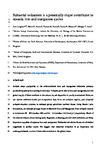Subaerial volcanism is a potentially major contributor to oceanic iron and manganese cycles
| dc.contributor.author | Longman, J | |
| dc.contributor.author | Palmer, M | |
| dc.contributor.author | Gernon, T | |
| dc.contributor.author | Manners, Hayley | |
| dc.contributor.author | Jones, M | |
| dc.date.accessioned | 2022-02-24T12:16:39Z | |
| dc.date.issued | 2022-03-14 | |
| dc.identifier.issn | 2662-4435 | |
| dc.identifier.issn | 2662-4435 | |
| dc.identifier.other | 60 | |
| dc.identifier.uri | http://hdl.handle.net/10026.1/18840 | |
| dc.description.abstract |
<jats:title>Abstract</jats:title><jats:p>Surface ocean availability of the micronutrients iron and manganese influences primary productivity and carbon cycling in the ocean. Volcanic ash is rich in iron and manganese, but the global supply of these nutrients to the oceans via ash deposition is poorly constrained. Here, we use marine sediment-hosted ash composition data from ten volcanic regions, and subaerial volcanic eruption volumes, to estimate global ash-driven nutrient fluxes. Using Monte Carlo simulations, we estimate average fluxes of dissolved Iron and Manganese from volcanic sources to be between 50 and 500 (median 180) and 0.6 and 3.2 (median 1.3) Gmol yr<jats:sup>−1</jats:sup>, respectively. Much of the element release occurs during early diagenesis, indicating ash-rich shelf sediments are likely important suppliers of aqueous iron and manganese. Estimated ash-driven fluxes are of similar magnitude to aeolian inputs. We suggest that subaerial volcanism is an important, but underappreciated, source of these micronutrients to the global ocean.</jats:p> | |
| dc.format.extent | 60- | |
| dc.language | en | |
| dc.language.iso | en | |
| dc.publisher | Nature Research | |
| dc.title | Subaerial volcanism is a potentially major contributor to oceanic iron and manganese cycles | |
| dc.type | journal-article | |
| dc.type | Journal Article | |
| plymouth.author-url | https://www.webofscience.com/api/gateway?GWVersion=2&SrcApp=PARTNER_APP&SrcAuth=LinksAMR&KeyUT=WOS:000768832300002&DestLinkType=FullRecord&DestApp=ALL_WOS&UsrCustomerID=11bb513d99f797142bcfeffcc58ea008 | |
| plymouth.issue | 1 | |
| plymouth.volume | 3 | |
| plymouth.publication-status | Published online | |
| plymouth.journal | Communications Earth & Environment | |
| dc.identifier.doi | 10.1038/s43247-022-00389-7 | |
| plymouth.organisational-group | /Plymouth | |
| plymouth.organisational-group | /Plymouth/Faculty of Science and Engineering | |
| plymouth.organisational-group | /Plymouth/Faculty of Science and Engineering/School of Geography, Earth and Environmental Sciences | |
| plymouth.organisational-group | /Plymouth/REF 2021 Researchers by UoA | |
| plymouth.organisational-group | /Plymouth/REF 2021 Researchers by UoA/UoA07 Earth Systems and Environmental Sciences | |
| plymouth.organisational-group | /Plymouth/Users by role | |
| plymouth.organisational-group | /Plymouth/Users by role/Academics | |
| dcterms.dateAccepted | 2022-02-18 | |
| dc.rights.embargodate | 2022-4-9 | |
| dc.identifier.eissn | 2662-4435 | |
| dc.rights.embargoperiod | Not known | |
| rioxxterms.versionofrecord | 10.1038/s43247-022-00389-7 | |
| rioxxterms.licenseref.uri | http://www.rioxx.net/licenses/all-rights-reserved | |
| rioxxterms.licenseref.startdate | 2022-03-14 | |
| rioxxterms.type | Journal Article/Review |


